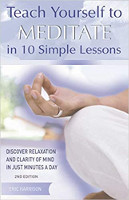
Image by Comfreak
Focusing keeps your eyes on the road, but awareness lets you enjoy the scenery. Almost all the satisfaction of a sitting comes not from watching the road but from those sideways glances at the scenery. The physiological shifts, the bodily tranquility, the pleasure of mental freedom are all part of the scenery. When you're focused, you only see the breath.
Since awareness is already part of every meditation, the instructions are unique to it. In an awareness meditation, you don't have any new object to focus on. It's more about shifting your emphasis when you meditate from focusing to watching, from spotlight consciousness to floodlight consciousness. You become a spectator.
In most meditations, you focus inwardly on the meditation object. When practicing awareness, you do the opposite. You still have a focal point, which could be anything at all, but most of your attention goes outward, "just watching" the passing thoughts and sensations.
When doing a formal breath meditation, for example, you would only notice other thoughts and sensations when they grab your attention. When practicing awareness, however, you may still be focusing on the breath, but you allow other thoughts to surface. You deliberately watch them pass through consciousness.
You try to keep the mind neutral. You aim for a bland, mirrorlike mind. You don't think about what is happening. You don't chase good things or resist bad ones as you usually would. You just notice what has walked in the door this minute and let it walk out again. As you can imagine, this doesn't come easily. Some visitors are very seductive.
A Typical Awareness Meditation
Let's assume you are meditating at the end of a busy day. You start in a beta state, tangled in thought. You soon realize you're thinking about Sally and work and money and a bunch of other stuff. These semiconscious irritations won't go away if you try to ignore them. They have to go out through the front door. As you name each thing, you break free somewhat and the breath is easier to focus on.
Then you realize Sally is back. Naming wasn't enough to get rid of her. This isn't surprising since she's been bugging you all day. The tangle of irritation, sadness and recriminations behind your inner dialogues now become obvious. Once you register your feelings and can see that further thinking isn't going to help, it is easier to let them go.
Notice that awareness doesn't solve the outer problem. It just changes your reaction to it. You stop fighting the imperfections of the moment and just let things happen. You feel a twinge of back pain; a motorbike goes past; you notice annoyance (you can't help it), and feel the annoyance fade; your breath feels soft and lovely; you feel anxious about money; then you realize you're thinking about the earthquake in Peru. And it's all okay if it just flows by.
On a larger scale, awareness means being comfortable with an uncomfortable world. You may tend to feel that you can't relax until the problems are all sorted out, but this is an unhealthy attitude. Issues around relationships, identity, money and so forth will go on for decades. You can't plan to relax when you're sixty-five, because stress will probably kill you first.
Not All Distractions Are Equal
Awareness is complicated because of the huge variety of things that go through consciousness. Some have a high emotional charge and some have a low one. It's easy to watch the pain of a slight headache. The pain of a bitter divorce is a different matter. It's even harder to just watch things that are gnawing at you unconsciously.
Each time you get distracted, you have a little challenge. Can you tolerate this without annoyance? Can you stay passive? The first strata of distractions are usually sensual things such as pains in the body or noises outside. Pretty soon you realize these don't need to be a problem. Being sensual, you can focus on them temporarily without breaking the meditation. If a tickle in the throat or a plane going past is the most obvious thing in the mind, why not focus on it for the time it's there?
However, you can't focus on thoughts this way. You can safely go into sensory things, but you have to pull back from thoughts. At the same time, you can't block out or ignore them. They do carry important messages and need at least a moment's attention. Usually by the time you label them, the mind has already assessed their importance and whether you can afford to drop them or not.
Being able to name your thoughts -- "Stephen, TV, work, Paris" -- will disarm most, but not all, of them. Often a thought won't let you go until you face the feelings behind it. If you chronically overeat, "food" can be too superficial a word to identify what's going on. Or if you're worried about a drug-addicted daughter, saying "Angela" doesn't encompass the matter.
If naming the content of a thought doesn't do much, then try naming the feeling behind it -- despair, or desire, or misery or contempt, for example. This will give a fuller picture. Often you can't think of any single word that fits. However, just to let the feeling register in consciousness usually quiets it down.
Notice that naming the thought or feeling is not complicated at all. It's just putting single word labels on to the dramas. Also, you're not avoiding them, as you do when you try to focus on an object. Since naming a thought is much cleaner than endlessly running stories around it, it saves energy and the body relaxes.
From Focus to Awareness
After you break the dominance of thoughts, awareness becomes quite easy and natural. In the alpha zone, you can balance focusing and awareness. You can be with the breath half the time and watch the stream for the rest.
You still have to be vigilant, but as the body settles, you get even more freedom. It becomes possible to watch the show as a spectator. This is how focusing, which is so important at the start, gradually gives way to a tolerant and versatile awareness.
As you watch what flows downstream, you become familiar over time with its huge variety and the way it changes as you relax. This is actually "you." It is the texture and contents of your mind.
You become able to watch every last thought, sensation, feeling and image, just as it is, without being entranced by it. You also see how it connects causally: how a thought leads to a feeling, which leads to a response in the body and often to action as well. These are some of the fruits of awareness that make it worth cultivating.
Meditation: Awareness, or "Just Watching"
Naming is the basic technique when you practice awareness, but you do it sparingly. Don't try to name everything. That would keep you very busy. Don't go looking for anything. Just name what is obvious and notice the rest without naming it.
Nonetheless, naming isn't essential. It's just a device to help you watch things with detachment, which is the real purpose of this meditation. If you are watching dispassionately, you don't need to name. Many things are too complex and subtle to be named anyway.
Originally I didn't enjoy naming and rarely did it. It felt like an unnecessary imposition. Only in recent years have I discovered how useful it is to precisely identify what is happening. Being able to name what's in the stream, even if you rarely verbalize it, can greatly refine your awareness.
INSTRUCTIONS
1. Relax and focus on any meditation object.
2. Make good contact with it. It is the seat from which you watch the stream.
3. Every few seconds, name the most obvious thing in the mind, whether it is important or not: "sore knee ... hungry ... TV ... money ... traffic...."
4. Don't lose contact with your basic meditation object. Spend at least half the time with it, and check that you're actually relaxing. In fact, go as deep into the object as you can without ignoring the peripheral thoughts and sensations.
5. Notice how the scenery changes the deeper you relax.
6. Notice that when you wait for thoughts, they often don't come!
7. Enjoy the bland, impersonal quality of the clear mind.
Reprinted with permission of the publisher,
Ulysses Press. ©2001, 2007. http://ulyssespress.com
Article Source
Teach Yourself to Meditate in Ten Simple Lessons: Discover Relaxation and Clarity of Mind in Just Minutes a Day
by Eric Harrison.
 Ideal for beginning students, this book guides the reader through a series of easy-to-follow core meditations that the author has found to be most effective. He explains what meditation is, why it works, and how to do it successfully. Also included are practical and enjoyable spot meditations that require only a few minutes a day.
Ideal for beginning students, this book guides the reader through a series of easy-to-follow core meditations that the author has found to be most effective. He explains what meditation is, why it works, and how to do it successfully. Also included are practical and enjoyable spot meditations that require only a few minutes a day.
If you are willing to invest 15 minutes a day, Teach Yourself to Meditate in 10 Simple Lessons can help you develop life-long skills that will improve your health, happiness and peace of mind. The course in this book doesn’t require you to follow a complex set of rules; rather, it teaches you the core practices, including: • Breathing • Posture • Mantras • Body Awareness • Visualization • Detachment
Info/Order this book (second edition). Also available as an Audiobook.
About the Author
 Trained in the Buddhist traditions of Burma and Tibet, Eric Harrison has practiced meditation for more than thirty years. After one particularly intensive retreat, he was encouraged by the monks to begin teaching meditation to others "in his own way." Over the years he has developed a method adapted to Western culture, one that eschews mysticism while emphasizing meditation's practical effects.
Trained in the Buddhist traditions of Burma and Tibet, Eric Harrison has practiced meditation for more than thirty years. After one particularly intensive retreat, he was encouraged by the monks to begin teaching meditation to others "in his own way." Over the years he has developed a method adapted to Western culture, one that eschews mysticism while emphasizing meditation's practical effects.
As the director of Perth Meditation Centre, Harrison worked closely with local doctors and patients to develop appropriate meditation programs for particular ailments. He is now retired. Visit his website at perthmeditationcentre.com.au.


























